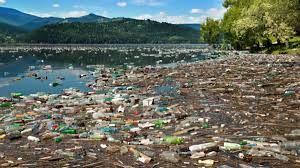Pollution has become a growing concern in recent years due to its disastrous effects on the environment and human health. From smog-filled cities to plastic-filled oceans, the impact of pollution can be seen all around us. While it can be overwhelming to think about the scale of the problem, it is important to understand the root causes of pollution in order to find sustainable solutions. In this blog post, we will explore the different types of pollution, their sources, and the impact they have on the environment. We will also discuss innovative solutions and technologies that are being developed to address pollution and protect the planet for future generations. By the end of this post, you will have a better understanding of the causes of pollution and the steps we can take to ensure a cleaner, healthier world.
- Introduction: The significance of understanding pollution and finding sustainable solutions
Introduction: The Significance of Understanding Pollution and Finding Sustainable Solutions
In today’s rapidly evolving world, pollution has become a pressing global issue that demands our immediate attention. The consequences of pollution, both for the environment and human health, are far-reaching and cannot be ignored any longer. It is crucial to gain a comprehensive understanding of the causes of pollution and work towards implementing sustainable solutions to mitigate its harmful effects.
Pollution, in its various forms such as air, water, and soil pollution, has detrimental impacts on ecosystems, biodiversity, and climate change. It disrupts the delicate balance of nature, leading to the degradation of habitats and the extinction of numerous species. Moreover, pollution poses significant health risks to humans, contributing to respiratory diseases, cardiovascular problems, and various other ailments.
To effectively combat pollution, it is vital to identify its root causes. Industrial emissions, vehicular exhaust, improper waste management, deforestation, and the use of non-renewable energy sources are just a few examples of human activities that contribute to pollution. By understanding these causes, we can take targeted actions to curtail them and create a cleaner and healthier environment for future generations.
Finding sustainable solutions is paramount in addressing pollution. This entails adopting practices and technologies that minimize the negative impact on the environment while promoting long-term ecological balance. Renewable energy sources, such as solar and wind power, offer a viable alternative to fossil fuels, reducing greenhouse gas emissions and air pollution. Implementing effective waste management systems, encouraging recycling initiatives, and promoting sustainable agriculture practices are also essential steps towards mitigating pollution.
Furthermore, raising awareness and educating individuals about the importance of sustainable practices is crucial. Empowering communities to make informed choices and advocating for policy changes can drive collective action towards a cleaner and more sustainable future. By working together, governments, organizations, and individuals can make significant strides in reducing pollution and preserving the planet for future generations.
In this blog series, we will delve deeper into the causes of pollution, explore sustainable solutions, and highlight real-world examples of successful initiatives. By gaining a comprehensive understanding of pollution and embracing sustainable practices, we can pave the way for a cleaner, healthier, and more sustainable world. Let us embark on this journey together and make a positive impact on our planet.
- Understanding the different types of pollution
Understanding the different types of pollution is crucial in tackling this global issue and finding sustainable solutions. Pollution comes in various forms, each with its unique characteristics and impacts on the environment and human health.
1. Air Pollution: One of the most visible and concerning forms of pollution, air pollution refers to the presence of harmful substances in the air we breathe. Sources of air pollution include industrial emissions, vehicle exhaust, burning fossil fuels, and indoor pollutants. It not only contributes to respiratory problems but also damages ecosystems and exacerbates climate change.
2. Water Pollution: Water pollution occurs when contaminants, such as chemicals, toxins, and waste, enter bodies of water like rivers, lakes, and oceans. Industrial discharges, agricultural runoff, improper waste disposal, and oil spills are major contributors to water pollution. This contamination poses a significant threat to marine life, ecosystems, and the availability of safe drinking water.
3. Soil Pollution: Soil pollution involves the accumulation of harmful substances in the soil, rendering it unfit for agricultural purposes or harming the plants and animals that depend on it. Industrial activities, improper waste disposal, and the use of pesticides and fertilizers contribute to soil pollution. Contaminated soil impacts food safety, reduces biodiversity, and affects overall ecosystem health.
4. Noise Pollution: Often overlooked but equally impactful, noise pollution refers to excessive or disturbing noise that disrupts the natural environment and human activities. This can arise from traffic, construction sites, industrial machinery, and even loud music. Prolonged exposure to noise pollution can lead to stress, hearing loss, and other detrimental health effects.
5. Light Pollution: Light pollution is the excessive or misdirected artificial light that disrupts natural darkness and interferes with ecosystems and human activities. It arises from excessive outdoor lighting, streetlights, and illuminated signs. Light pollution not only affects stargazing and wildlife but also disrupts natural sleep patterns and has implications for human health.
Understanding these different types of pollution is the first step towards finding effective and sustainable solutions. By identifying the sources, causes, and impacts of pollution, we can work towards implementing measures to reduce pollution levels, promote eco-friendly practices, and create a healthier and cleaner environment for future generations.
- Air pollution: Causes and effects on human health and the environment
Air pollution is a pressing issue that has profound effects on both human health and the environment. Understanding the causes of air pollution is crucial to finding sustainable solutions and mitigating its harmful impacts.
There are various sources of air pollution, both natural and human-made. Natural sources include volcanic eruptions, dust storms, and wildfires, which release pollutants such as ash, smoke, and particulate matter into the air. However, the majority of air pollution is attributed to human activities.
Industrial emissions, particularly from power plants, factories, and vehicles, contribute significantly to air pollution. These emissions release harmful pollutants such as carbon monoxide, sulfur dioxide, nitrogen oxides, and particulate matter. Additionally, the burning of fossil fuels for energy production and transportation releases greenhouse gases, including carbon dioxide, which contributes to climate change.
The effects of air pollution on human health are far-reaching. Exposure to high levels of pollutants can lead to respiratory problems, allergies, and increased risk of cardiovascular diseases. Long-term exposure to polluted air has also been linked to lung cancer, asthma, and even developmental issues in children. Moreover, air pollution has environmental consequences, such as the depletion of ozone in the upper atmosphere, contributing to the greenhouse effect and climate change.
To address the causes and effects of air pollution, sustainable solutions are imperative. Implementing cleaner and more efficient technologies in industries and transportation is crucial. Additionally, promoting renewable energy sources, such as solar and wind power, can help reduce reliance on fossil fuels and decrease pollution levels. Improving public transportation systems, encouraging the use of electric vehicles, and promoting cycling and walking can also contribute to reducing air pollution.
Furthermore, raising awareness about the importance of air quality and implementing stricter regulations and policies are necessary steps towards tackling this issue. Engaging in sustainable practices, such as conserving energy, reducing waste, and planting trees, can also play a role in improving air quality and creating a healthier environment for future generations. By understanding the causes of air pollution and taking proactive measures, we can work towards a cleaner and more sustainable future.
- Industrial pollution: Impact on air quality and steps for sustainable industrial practices
Industrial pollution is a significant contributor to air pollution, with its detrimental effects on both human health and the environment. The emissions released from factories, power plants, and manufacturing facilities not only degrade the air quality but also contribute to climate change.
The impact of industrial pollution on air quality cannot be underestimated. Harmful substances such as particulate matter, sulfur dioxide, nitrogen oxides, and volatile organic compounds are released into the atmosphere during industrial processes. These pollutants not only pose immediate health risks to nearby communities but also have long-term consequences, including respiratory diseases, cardiovascular issues, and even cancer.
However, the good news is that there are steps that industries can take to adopt sustainable practices and reduce their environmental footprint. Implementing cleaner production technologies and utilizing renewable energy sources can significantly reduce emissions and improve air quality. By investing in energy-efficient equipment, optimizing production processes, and adopting waste management strategies, industries can minimize their pollution output.
Additionally, promoting circular economy principles can play a crucial role in achieving sustainable industrial practices. By focusing on resource efficiency, waste reduction, and recycling, industries can minimize their reliance on raw materials and reduce the generation of hazardous wastes.
Collaboration between industries, regulatory bodies, and environmental organizations is vital in driving the adoption of sustainable practices. Governments can enforce stricter regulations and provide incentives for industries to invest in cleaner technologies. At the same time, businesses need to prioritize sustainability and take responsibility for their environmental impact.
By embracing sustainable industrial practices, we can mitigate the negative effects of industrial pollution on air quality. This not only benefits the health and well-being of local communities but also contributes to a cleaner and healthier planet for future generations. It is imperative for industries to recognize their role in pollution and actively work towards implementing sustainable solutions to ensure a greener and more sustainable future.
- Vehicular pollution: Challenges and potential solutions for reducing emissions
Vehicular pollution is a significant contributor to air pollution, causing detrimental effects on both human health and the environment. The emissions released from cars, trucks, and motorcycles contain harmful pollutants such as carbon monoxide, nitrogen oxides, and particulate matter. These pollutants not only deteriorate air quality but also contribute to global warming and climate change.
One of the main challenges in reducing vehicular emissions is the sheer number of vehicles on the road. With the increasing population and urbanization, the demand for transportation has grown exponentially. This has led to a rise in the number of vehicles, especially in densely populated cities, resulting in higher pollution levels.
To tackle this challenge, sustainable solutions need to be implemented. One such solution is the promotion of electric vehicles (EVs). Electric vehicles are powered by electricity, which significantly reduces or eliminates tailpipe emissions. Governments and policymakers should incentivize the adoption of EVs by offering tax credits, subsidies, and establishing a robust charging infrastructure network.
Another potential solution is the improvement of public transportation systems. Encouraging people to use buses, trams, or trains instead of private vehicles can significantly reduce vehicular emissions. Investing in efficient and reliable public transportation options, along with providing subsidies or discounted fares, can incentivize people to choose public transport as their preferred mode of travel.
Furthermore, implementing stricter emission standards for vehicles can also play a crucial role in reducing pollution. Governments should enforce regulations that require vehicle manufacturers to produce cars with lower emissions and invest in innovative technologies such as hybrid engines or hydrogen fuel cells.
Additionally, promoting alternative modes of transportation, such as cycling or walking, can help reduce vehicular pollution for short-distance travel. Creating dedicated cycling lanes, pedestrian-friendly infrastructure, and encouraging a culture of active transportation can go a long way in reducing reliance on cars for short trips.
In conclusion, addressing vehicular pollution requires a multi-faceted approach involving the promotion of electric vehicles, improvement of public transportation systems, stricter emission standards, and encouraging alternative modes of transportation. By implementing these sustainable solutions, we can mitigate the adverse effects of vehicular pollution and pave the way towards cleaner, healthier, and more sustainable cities.
- Agricultural pollution: The role of farming practices in air pollution and sustainable agriculture methods
Agricultural pollution is a significant contributor to air pollution, and understanding its causes is crucial in finding sustainable solutions for a cleaner environment. Farming practices, such as the use of chemical fertilizers and pesticides, livestock waste management, and agricultural burning, can release harmful pollutants into the air.
Chemical fertilizers and pesticides, when used excessively or improperly, can emit nitrogen oxides and volatile organic compounds (VOCs) into the atmosphere. These pollutants contribute to smog formation and can have detrimental effects on human health. Additionally, the runoff from these chemicals can contaminate water sources, further exacerbating environmental issues.
Livestock waste management is another significant factor in agricultural pollution. The decomposition of animal manure releases methane, a potent greenhouse gas that contributes to global warming. Moreover, the improper storage and disposal of manure can lead to the release of ammonia and other air pollutants.
Agricultural burning, practiced in some regions to clear fields or crop residues, releases large amounts of smoke, particulate matter, and air pollutants. These emissions not only degrade air quality but also pose health risks to nearby communities.
To address agricultural pollution and promote sustainable agriculture, various methods can be implemented. Integrated pest management (IPM) techniques can help reduce the reliance on chemical pesticides by using natural pest control methods, crop rotation, and biological controls. Precision agriculture technologies, such as GPS-guided equipment and sensor-based systems, can optimize the use of fertilizers, minimizing their environmental impact.
Furthermore, implementing proper waste management systems for livestock can significantly reduce methane emissions. Technologies like anaerobic digesters can capture and convert methane into usable energy, benefiting both the environment and farmers.
Promoting alternative practices to agricultural burning, such as incorporating crop residues back into the soil or utilizing them as biomass for energy production, can help mitigate air pollution caused by this practice.
Education and awareness among farmers and policymakers are crucial in driving the adoption of sustainable agricultural practices. Providing incentives and support for farmers to transition towards environmentally friendly methods can lead to long-term benefits for both the environment and agricultural productivity.
By understanding the causes of agricultural pollution and embracing sustainable farming practices, we can work towards a future where agriculture coexists harmoniously with a clean and healthy environment.
- Indoor pollution: Identifying common indoor pollutants and strategies for improving indoor air quality
Indoor pollution may not be as visible as its outdoor counterpart, but it can have a significant impact on our health and well-being. Understanding the causes of indoor pollution is the first step towards finding sustainable solutions to improve indoor air quality.
Common indoor pollutants can come from various sources, including volatile organic compounds (VOCs) emitted by cleaning products, furniture, and building materials. Other sources include mold, tobacco smoke, pet dander, and dust mites. These pollutants can accumulate over time and lead to respiratory issues, allergies, and other health problems.
To tackle indoor pollution and improve air quality, it is essential to identify and address these sources. One strategy is to opt for environmentally friendly cleaning products that are low in VOCs and avoid using products with strong chemical odors. Choosing furniture and building materials that have low VOC emissions can also help reduce indoor pollution.
Proper ventilation plays a crucial role in maintaining good indoor air quality. Opening windows regularly to allow fresh air to circulate can help dilute pollutants and improve ventilation. Additionally, using air purifiers and ventilation systems with high-efficiency filters can effectively remove airborne particles and allergens, providing cleaner air for occupants.
Controlling moisture levels is another important factor in preventing mold growth, which can contribute to indoor pollution. Regularly inspecting and addressing any signs of leaks or water damage is essential in maintaining a healthy indoor environment.
Educating occupants about the importance of indoor air quality and promoting sustainable practices can also be beneficial. Encouraging smoking cessation, implementing policies to reduce secondhand smoke exposure, and promoting the use of green spaces and natural lighting can contribute to a healthier indoor environment.
By identifying common indoor pollutants and implementing strategies to improve indoor air quality, we can create healthier and more sustainable living and working spaces. Clearing the air of indoor pollution is not only essential for our own well-being but also for the long-term health of our planet.
- Global efforts and policies to combat pollution
In recent years, there has been a growing awareness of the detrimental effects of pollution on our planet and the urgent need for global action. Governments, international organizations, and communities around the world have recognized the importance of implementing policies and initiatives to combat pollution and protect our environment.
One significant global effort in this regard is the Paris Agreement, a landmark international treaty adopted in 2015. The agreement aims to limit global warming and reduce greenhouse gas emissions to mitigate the harmful impacts of climate change. It has been ratified by numerous countries, highlighting the collective commitment towards addressing pollution on a global scale.
Additionally, many countries have implemented their own policies and regulations to combat pollution. These include setting emission standards for industries, promoting the use of renewable energy sources, and incentivizing sustainable practices. For instance, some countries have introduced carbon pricing mechanisms to encourage businesses to reduce their carbon footprint.
Furthermore, international organizations such as the United Nations Environment Programme (UNEP) and the World Health Organization (WHO) play a crucial role in coordinating and facilitating global efforts to combat pollution. They provide guidance, support research, and promote sustainable practices across various sectors.
On a local level, communities and individuals are also taking action to reduce pollution. From participating in clean-up campaigns to advocating for sustainable transportation options, grassroots movements are making significant contributions to the overall efforts.
It is important to recognize that combating pollution requires a multi-faceted approach. It involves collaboration between governments, industries, communities, and individuals. By working together and implementing sustainable solutions, we can make a positive impact and create a cleaner and healthier environment for future generations.
- Individual actions for reducing pollution and promoting sustainability
Individual actions play a crucial role in reducing pollution and promoting sustainability. While it may seem overwhelming to tackle such a global issue on an individual level, every small step makes a difference. Here are some actionable ways you can contribute to cleaner air and a more sustainable future:
1. Reduce, reuse, recycle: Adopt a conscious approach towards waste management by minimizing the use of single-use plastics, opting for reusable alternatives, and segregating waste for recycling. Remember, even small changes like carrying a reusable water bottle or shopping with reusable bags can have a significant impact over time.
2. Conserve energy: Be mindful of your energy consumption at home and at work. Turn off lights and electronics when not in use, unplug chargers, and invest in energy-efficient appliances. Consider switching to renewable energy sources or supporting clean energy initiatives in your community.
3. Choose sustainable transportation: Opt for walking, cycling, or using public transportation whenever possible. If you need to use a car, carpooling or using electric vehicles can significantly reduce carbon emissions. Additionally, plan your trips efficiently to minimize fuel consumption.
4. Support local and sustainable businesses: Make a conscious effort to support businesses that prioritize sustainability practices. Look for certifications such as organic, fair trade, or eco-friendly labels when purchasing products. By supporting these businesses, you are encouraging others to follow suit, creating a positive ripple effect.
5. Plant trees and create green spaces: Trees play a vital role in purifying the air by absorbing carbon dioxide and releasing oxygen. Consider participating in tree planting initiatives or creating green spaces in your community. Even a small balcony garden can contribute to improving air quality.
6. Educate and spread awareness: Share your knowledge and experiences with others. Engage in conversations about pollution, sustainability, and the importance of collective action. Encourage your friends, family, and colleagues to adopt sustainable practices and make informed choices.
Remember, no action is too small when it comes to combating pollution and promoting sustainability. By making conscious choices in our daily lives, we can contribute to a cleaner and healthier environment for ourselves and future generations. Let’s take responsibility and be the change we wish to see.
- Conclusion: The importance of collective action and continued awareness in addressing pollution
In conclusion, it is evident that addressing pollution requires collective action and continued awareness. Pollution is a complex issue that affects every aspect of our lives, from the air we breathe to the water we drink and the environment we live in. It is not a problem that can be solved by individuals alone; it requires the cooperation and collaboration of governments, industries, communities, and individuals.
The first step in addressing pollution is understanding its causes. We have explored various sources of pollution, including industrial emissions, vehicular pollution, improper waste management, and deforestation. By identifying these causes, we can work towards finding sustainable solutions that target the root of the problem.
Sustainable solutions involve adopting practices that minimize pollution and promote environmental stewardship. This may include transitioning to renewable energy sources, implementing stricter regulations on emissions, promoting recycling and waste reduction, and investing in green technologies. By embracing these solutions, we can reduce our ecological footprint and create a healthier and cleaner environment for future generations.
However, it is crucial to note that our efforts should not stop at individual actions or short-term solutions. It is imperative to maintain a collective commitment to addressing pollution and to continuously raise awareness about its impacts. By educating ourselves and others, we can create a widespread understanding of the importance of sustainable practices and inspire others to take action.
In conclusion, addressing pollution requires a multi-faceted approach that involves the participation and cooperation of all stakeholders. By working together, we can create a sustainable future where pollution is minimized, and our environment is protected. Let us remember that the choices we make today will have a lasting impact on the world we leave behind for future generations.
We hope you found our blog post on understanding the causes of pollution and finding sustainable solutions informative and eye-opening. Pollution is a pressing issue that affects us all, but by understanding its root causes and exploring sustainable solutions, we can make a positive impact on our environment and future generations. Remember, small changes in our daily lives can have a big impact, so let’s work together to clear the air and create a cleaner, healthier world for all. Thank you for joining us on this journey towards a more sustainable future.



